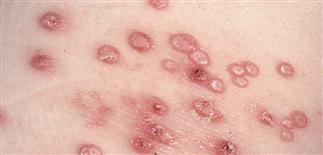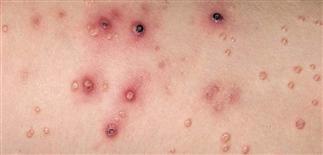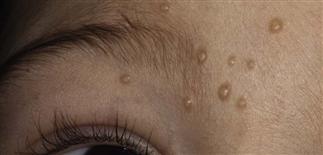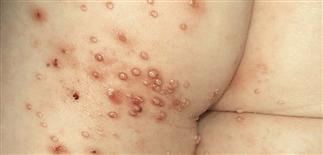62
Molluscum contagiosum

Papules of molluscum contagiosum are somewhat firm and flesh-colored to pink. They have a central core, composed of hundreds of infectious particles from which spread may occur.

Inflammation is evident in several molluscum papules. This inflammation often leads to resolution of the papules.

Molluscum papules in a child in the periorbital region. Lesions can be spread by picking and scratching. Treatment is difficult; lesions will resolve with development of cellular immunity.

Grouped papules scattered on the buttocks and thigh. Some of the lesions have been picked and appear crusted.
DESCRIPTION
A poxvirus infection of the skin characterized by discrete umbilicated papules. Genital molluscum contagiosum in adults should be considered a sexually transmitted disease. Genital molluscum contagiosum is common in children; sexual abuse is not necessarily the cause. More common if immune suppressed.
HISTORY
• Very common in children. • Spread by direct contact or autoinoculation. • Lesions tend to be more numerous and spread rapidly in patients with atopic dermatitis or those with a decreased skin barrier. • Lesions may become extremely large and disfiguring in patients with HIV.
PHYSICAL FINDINGS
• Discrete, 2- to 5-mm, slightly umbilicated, flesh-colored, and dome-shaped lesions appear. The pubic and genital areas are most commonly involved in adults. Lesions are frequently grouped and cover a wide area. • Inflammation, erythema, and scaling at the periphery of a single or several lesions may occur. This may be the result of inflammation from scratching, or it may be a hypersensitivity reaction. • Trauma may alter the characteristic appearance of some lesions. • Papules often camouflaged by pubic hair. Most patients have just a few lesions that can be easily overlooked. The focus of examination is the pubic area, genitals, anal area, thighs, trunk. Lesions may appear anywhere except the palms and soles. • Molluscum contagiosum lesions are often confused with warts.
TREATMENT
• Genital molluscum lesions should be treated to prevent spread through sexual contact. • New lesions too small to be detected at first examination may appear after treatment and require attention at subsequent visit. Options: Small papules can be quickly removed with a curette with or without local anesthesia. • Cryosurgery with liquid nitrogen is the treatment of choice for patients who do not object to the pain. A conservative approach is necessary, because excessive freezing produces hypopigmentation or hyperpigmentation. • A small drop of cantharidin 0.7% (Cantharone) is applied with the stick end of a cotton swab over the surface of the lesion, and contamination of normal skin is avoided. This should be washed off 4–6 h later. Lesions blister and may resolve without scarring. New lesions occasionally appear at the site of the blister created by cantharidin. Hypopigmentation or hyperpigmentation may occur. • Imiquimod (Aldara) 5% cream can be effective when applied three times weekly at night for 2–3 months. This is especially effective for treating facial molluscum in children, where scarring procedures are contraindicated.







